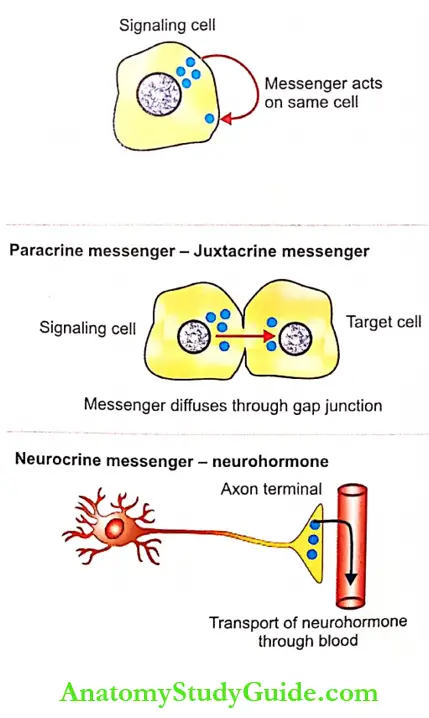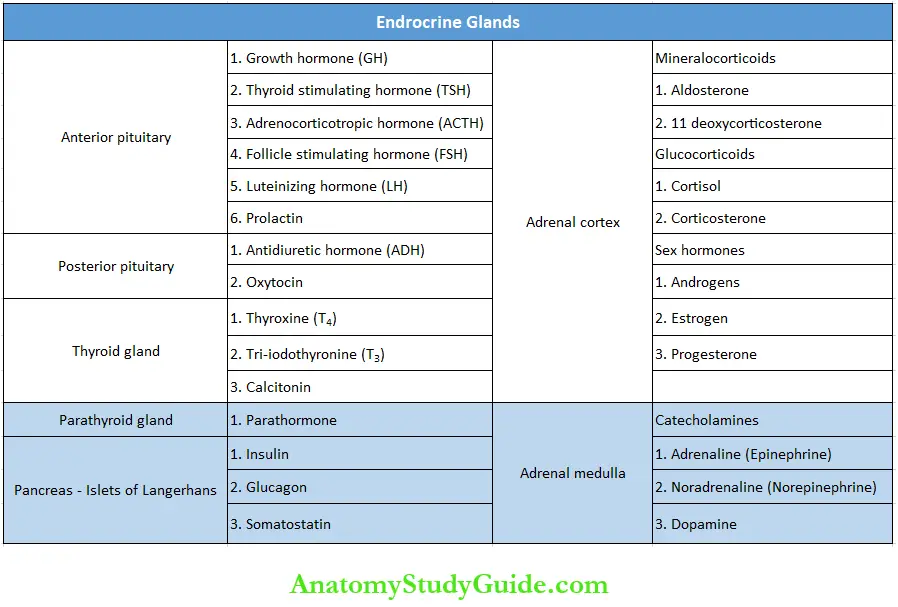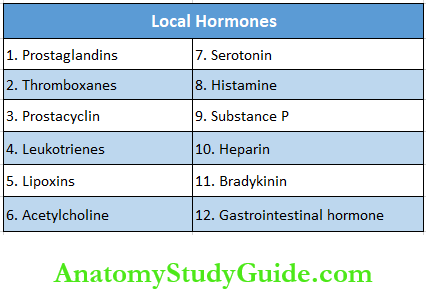Introduction Of Endocrinology
All physiological activities are regulated by two major systems in the body.
Table of Contents
- Nervous system
- Endocrine system.
These two systems interact with one another and regulate the body’s functions. This section deals with endocrine system and Section 10 deals with nervous system. Endocrine system functions by secreting so chemical substances called hormones.
Read And Learn More: Medical Physiology Notes
1. Cell To Cell Signaling: Cell-to-cell signaling refers to the transfer of information from one cell to another. It is also called cell signaling or intercellular communication. The cells of the body communicate with each other through some chemical substances called chemical messengers.
2. Chemical Messengers
- The chemical messengers are the substances involved in cell signaling. These messengers are mainly secreted from endocrine glands. Some chemical messengers are secreted by nerve endings and the cells of several other tissues also.
- All these chemical messengers carry the message (signal) from the signaling cells (controlling cells) to the target cells. The messenger substances may be the hormones or hormone-like substances.
Classification of Chemical Messengers: Generally chemical messengers are classified into two types
-
- Classical hormones secreted by endocrine glands
- Local hormones secreted from other tissues.
However, a recent method of classification divides chemical messengers into four types:
- Ensocrine messengers
- Paracrine messengers
- Autocrine messengers
- Neurocrine messengers.
- Endocrine Messengers: The endocrine messengers are the classical hormones. A hormone is defined as a chemical messenger synthesized by endocrine glands and transported by blood to the target organs or tissues (site of action). Examples are growth hormone and insulin.
- Paracrine Messengers:
- The paracrine messengers are the chemical messengers, which diffuse from the control cells to the target cells through the interstitial fluid.
- Some of these substances directly enter the neighboring target cells through gap junctions.
- Such substances are also called juxtacrine messengers or local hormones. Examples are prostaglandins and histamine.
- Autocrine Messengers: Autocrine messengers are the chemical messengers that control the source cells which secrete them. So these messengers are also called intracellular chemical mediators. Examples are leukotrienes.
- Neurocrine or Neural Messengers: Neurocrine or neural messengers are neurotransmitters and neurohormones.
- Neurotransmitter: Neurotransmitter is an endogenous signaling molecule that carries information form one nerve cell to another nerve cell or muscle or other tissue. Examples are acetylcholine and dopamine.
- Neurohormone:
- Neurohormone is a chemical substance that is released by the nerve cell directly into the blood and transported to distant target cells. Oxytocin, antidiuretic hormone, and releasing hormones secreted by hypothalamus are the examples.
- Some of the chemical mediators act as more than one type of chemical messenger. For example, nor-adrenalin and dopamine function as classical hormones as well as neurotransmitters. Similarly, histamine acts as a neurotransmitter and paracrine messenger.


3. Endocrine Glands
- Endocrine glands are the glands which synthesize and release the classical hormones into the blood. The endocrine glands are also called ductless glands because the hormones secreted by them are released directly into blood without any duct.
- Endocrine glands are distinct from exocrine glands which release their secretions through ducts.
- The endocrine glands play an important role in homeostasis and control of various other activities in the body through their hormones.
- The hormones are transported by blood to the target organs or tissues in different parts of the body, where the actions are executed.
- Major endocrine glands are shown.
- The hormones secreted by the major endocrine glands are listed in Table.
- The hormones secreted by the gonads are given in Table.
- The hormones secreted by other organs are given in Table.
- The local hormones are listed in Table.
Methods Of Endocrine Glands Study
Study Of Endocrine Glands: The following methods are followed to study an endocrine gland:
- Functional Anatomy
- Situation
- Divisions or parts
- Histology
- Blood supply
- Nerve supply.
- Functions
- Hormones secreted by the gland
- Actions of each hormone.
- Evidence to Support the Functions of the Gland
- Effects of extirpation (removal) of the gland
- Effects of administration of extract or the hormone of the gland
- Clinical observation.
- Regulation of Activity of the Gland
- By other endocrine glands
- By other factors
- By feedback mechanism.
- Applied Physiology
- Disorders due to hyperactivity of the gland
- Disorders due to hypoactivity of the gland.





Study Of Hormones: A hormone is usually studied as follows:
- Source of secretion (gland as well as the cell that secretes the hormone)
- Chemistry
- Half-life
- Synthesis and metabolism
- Actions
- Mode of action
- Regulation of secretion
- Applied physiology
- Disorders due to hypersecretion of the hormone
- Disorders due to hyposecretion of the hormone.
The half-life of the Hormones
- Half-life is defined as the time during which half the quantity of a hormone, drug, or any substance is metabolized or eliminated from circulation by biological process.
- It is also defined as the time during which the activity or potency of a substance is decreased to half of its initial value.
- Half-life is also called biological half-life. The half-life of a hormone denotes the elimination of that hormone from circulation.
Study Of Endocrine Disorders: An endocrine disorder is studied by analyzing
- Causes
- Signs and symptoms
- Syndrome
1. Endocrine Disorders Causes: Endocrine disorder may be due to the hyperactivity or hypoactivity of the concerned gland. The secretion of hormones is increased during hyperactivity and decreased during dinner hypoactivity.
2. Endocrine Disorders Signs and Symptoms
- A sign is the feature of a disease as detected by the doctor during the physical examination. So it is the objective physical evidence of the disease found by the examiner.
- Examples of signs are yellow coloration of skin and mucous membrane in jaundice, paleness in anemia, enlargement of liver, etc.
- A symptom is the feature of a disease felt by the patient. So it is the subjective evidence perceived by the patient.
- In simple words it is a noticeable change in the body experienced by the patient. Examples of symptoms are fever, itching, swelling, tremor, etc.
3. Endocrine Disorders Syndrome: Syndrome is the combination of signs and symptoms (associated with a disease) that occur together and suggest the presence of a certain disease or the possibility of developing the disease.
Leave a Reply